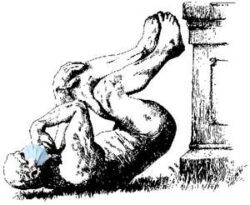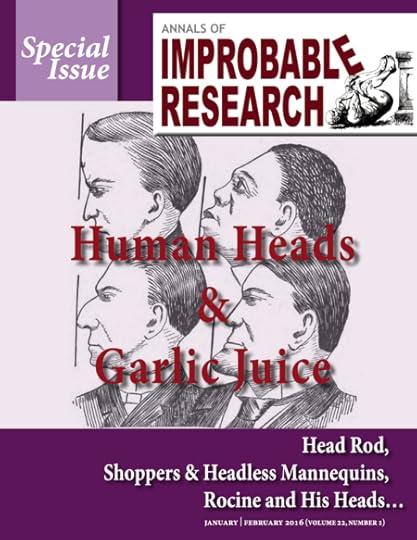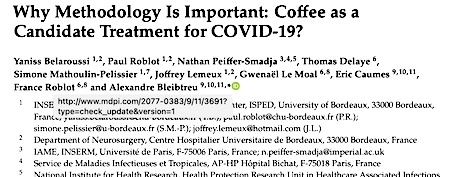Marc Abrahams's Blog, page 95
November 26, 2020
Passionate Kissing and National Income Inequality [Ig Informal Lecture]
Here is the Ig Informal Lecture by the winners of the 2020 Ig Nobel Economics Prize.
The Ig Nobel Prizes honor achievements that make people LAUGH, then THINK. In the Ig Informal Lectures, some days after the ceremony, the new Ig Nobel Prize winners attempt to explain what they did, and why they did it. [In non-pandemic years, the lectures happen at MIT, in Cambridge, Massachusetts, two days after the Ig Nobel Prize ceremony. But in the pandemic year 2020, it’s all happening online.]
The 2020 Ig Nobel Prize for Economics was awarded to Christopher Watkins, Juan David Leongómez, Jeanne Bovet, Agnieszka Żelaźniewicz, Max Korbmacher, Marco Antônio Corrêa Varella, Ana Maria Fernandez, Danielle Wagstaff, and Samuela Bolgan, for trying to quantify the relationship between different countries’ national income inequality and the average amount of mouth-to-mouth kissing.
They documented that research, in the study “National Income Inequality Predicts Cultural Variation in Mouth to Mouth Kissing,” Christopher D. Watkins, Juan David Leongómez, Jeanne Bovet, Agnieszka Żelaźniewicz, Max Korbmacher, Marco Antônio Corrêa Varella, Ana Maria Fernandez, Danielle Wagstaff, and Samuela Bolgan, Scientific Reports, vol. 9, article no. 6698, 2019.

The point of the Ig
 The Weiter Denken blog distilled, into about 700 words, the essence of the Ig Nobel Prizes. Here’s a machine translation, from German into English, of what they wrote:
The Weiter Denken blog distilled, into about 700 words, the essence of the Ig Nobel Prizes. Here’s a machine translation, from German into English, of what they wrote:
A prize for the square from the round
Scientists always keep to themselves in the academic ivory tower? The Ig Nobel Prize proves that there is another way – a prime example of successful communication on rather demanding topics.
The Ig Nobel Prize puts research results in the spotlight that would otherwise probably never have been heard of. For example, why wombat droppings are square or how much saliva a person produces in a day. What these questions have in common is that they seem bizarre at first glance, but are highly relevant for business and progress. Those who devote themselves to such topics have, with a bit of luck, been honored in a solemn, but definitely not time-honored ceremony since 1991. A good atmosphere is created when the personified human error – a man with a target in front of his stomach – is pelted with paper airplanes and a little girl loudly (and persistently!) Calls on the winners in their acceptance speeches after exactly 60 seconds to end come. A spectacle
But it is not just this spectacle that makes the Ig Nobel Prize so successful. Because despite all the fun, its inventor, Marc Abrahams, is pursuing a serious goal: The format should offer alternative access to today’s science and draw attention to the relevance that even seemingly bizarre research can have. Making the audience laugh at it is a means to an end. Because this way the topics stay in your head in a special way – which then makes you wonder why researchers are concerned with such a topic. Why this format works so well is ultimately a communicative question. In the following we want to break down the success mechanisms.
Simplification creates understanding
In the presentation of research, the Ig Nobel Prize reduces the respective topics to their core. Hard work, as the inventor admits. Distracting detailed information about the experiments is sorted out and the central message, which we should laugh about first and then think about, stands out. For example, when a researcher like Fritz Strack is honored for refuting himself. Like him, countless psychologists feel when the results of social experiments inexplicably cannot be repeated – a complex dilemma due to the interplay of countless factors. The focus on the bare end result, however, allows people who are not specialists to grasp and understand the complex problem.
Shortening prevents excessive demands
At the same time, this reduction shortens the topics presented so that they are not only easy to understand but also quick. In this way, research that otherwise fills entire books is made accessible to the masses without overloading it with too much information – for example, by reducing the replication dilemma of psychology to a ballad that can be performed in just 60 seconds. Because in a time when people seem to be chronically short of time, it is essential to get to the point quickly.
Show value generates attention
It is also important to generate interest and attention. With the Ig Nobel Prize, this succeeds almost automatically by setting unique themes and the wonderfully eccentric traditions (such as throwing paper planes). The fact that real Nobel Prize winners regularly present the Ig Nobel Prize provides additional impetus and at the same time ennobles the event. This recognition of the award by the academic community shows that this is not a mocking display of unusual research, but a new format for presenting serious science.
Humor makes topics more accessible
With the winking celebration of science in all its facets – the successful and sometimes also the failed – the Ig Nobel Prize makes topics palatable to laypeople that they might otherwise avoid. Because humor offers information packed in entertainment. That hits the nerve of scientists and laypeople alike. The result is a new communication format that multiplies by itself – in that the media and communication professionals worldwide report on it.
The Ig Nobel Prize is thus a successful piece of (science) communication, from which we can certainly cut off one or the other slice of inspiration for our daily work.

November 24, 2020
A slightly mysterious book about a blowhard
Several databases include mention of a book titled “The death of Booth: Affidavit Dec. 1, 1904 in pension claim of Wm. H. Collyer, a blowhard.” Apparently it is brief—just three pages long.
We have been unable to find a copy of that book. If you have a copy, we would enjoy seeing an image of the cover and the insides.

November 23, 2020
Recent progress in Pokémon GO studies
 Since its launch in 2016 Pokémon GO has attracted a wealth of academic studies – covering the social, psychological, medical, security and legal aspects of the game.
Since its launch in 2016 Pokémon GO has attracted a wealth of academic studies – covering the social, psychological, medical, security and legal aspects of the game.
[ For those not familiar with the subject, here is some background : Pokémon GO is an augmented reality (AR) mobile game for iOS and Android devices. It was developed and published by Niantic in collaboration with The Pokémon Company ]
Here are some examples of scholarly studies (no particular order)
• Analysis of Pokémon GO using sociophysics approach
• Is Pokemon GO feminist? An actor-network theory analysis
• Videogame-Related Illness and Injury: A Review of the Literature and Predictions for Pokemon GO!
• Correlates of excessive Pokemon Go playing among medical students
• What the Pokemon Go have study adolescents for?
• Could Pokemon Go boost birding?
• Who is still playing pokemon Go? a Web-based survey
BONUS : Interview with the scientists who wrote the paper about Pokémon Improbable Research, 2016
Resarch research by Martin Gardiner

November 22, 2020
Pocket-Sized #1043: “Leaping Fish Injuries”
In Pocket-Sized episode #1043, Marc Abrahams shows an unfamiliar research study to Nicole Sharp. Dramatic readings and reactions ensue.
The research mentioned in this episode is featured in the special Human Heads & Garlic Juice issue (Vol. 22, #1) of the Annals of Improbable Research Magazine.

Remember, our Patreon donors, on most levels, get access to each podcast episode before it is made public.
Nicole Sharp encounters:
“Sturgeons Versus Surgeons: Leaping Fish Injuries at a Level 1 Trauma Center,” Jason P. Wilson, George Burgess, Robert D. Winfield, and Lawrence Lottenberg, The American Surgeon, vol. 75, no. 3, 2009, pp. 220-222.
Seth Gliksman, Production Assistant
Available on Spotify, Apple Podcasts, Overcast, Google Podcasts, AntennaPod, BeyondPod and elsewhere!

A look back at more sex from A Slob
A Slob was appreciated twelve years ago, in the September, 2008 issue of mini-AIR. Let’s take a fond look back:
2008-09-08 More Sex From A. Slob
Investigator P.J. Finn complains that we have neglected the once-popular feature called “Sex From A. Slob.” Dr. Slob, investigator Finn reminds us, is based at Erasmus University, Rotterdam. To lessen investigator Finn’s unhappiness, the series resumes:
SEX FROM A. SLOB (1)
“Sexual Arousability and the Menstrual Cycle,” A. Koos Slob, et al., Psychoneuroendocrinology. vol. 21, no. 6, August 1996, pp. 545-58.
SEX FROM A. SLOB (2)
“Age, Libido, and Male Sexual Function,” A. Koos Slob, Prostate, vol. 10, 2000, pp. 9-13.
That same issue of min-AIR included a rare star turn from science limericist R. Burpee Bohaker.
There was, too, a preview of that year (2008)’s Ig Nobel Prize ceremony:
2008-09-06 More about the Ig
More of what’s on tap at the ceremony:
This year’s 24/7 Lecturers (each explaining a subject first in 24 seconds, then in seven words) and their topics:
Benoit Mandelbrot: Fractals
Anna Lysyanskaya: Cryptography
Steven Pinker: The Human Mind
Dany Adams: Biology
William Lipscomb: Redundancy
The ceremony will include the Win-a-Date-With-Benoit-Mandelbrot Contest, and the premiere, for the first time, of the mini-opera “Redundancy, Again.”
Also, several past winners are returning to take a bow.

November 21, 2020
Coffee as a medical treatment for Covid-19
Is coffee an effective medicine to deal with Covid-19? A large team of researchers in France and the UK explore whether that question—the question, not the coffee—is a good way to get people thinking about:
how difficult it can be to find an effective treatment for any problem, and
how easy it can be to produce unreliable, shoddy answers, and
how easy it can be to pay attention to unreliable, shoddy answers
The study is: “Why Methodology Is Important: Coffee as a Candidate Treatment for COVID-19,” Yaniss Belaroussi, Paul Roblot, Nathan Peiffer-Smadja, Thomas Delaye, Simone Mathoulin-Pelissier, Joffrey Lemeux, Gwenaël Le Moal, Eric Caumes, France Roblot, and Alexandre Bleibtreu, Journal of Clinical Medicine, vol. 9, no. 11, 2020, 36912020.
The abstract begins:
Background: During this pandemic situation, some studies have led to hasty conclusions about Corona Virus Disease-19 (COVID-19) treatment, due to a lack of methodology. This pedagogic study aimed to highlight potential biases in research on COVID-19 treatment.
Methods: We evaluate the effect of coffee’s active part, 1,3,7-trimethylxanthine (TMX) on patients with COVID-19. A cohort of 93 patients, with a diagnosis of COVID-19 is analyzed.
The authors proceed to do an intentionally sloppy, bad piece of not-even-research. Having lured the audience in with their implicit offer of coffee, they then serve up an unappetizing but valuable hot gulp:
Conclusions: Multiple biases prevents us from concluding to an effect of coffee on COVID-19. Despite an important social pressure during this crisis, methodology and conscientiousness are the best way to avoid hasty conclusions that can be deleterious for patients.

November 20, 2020
Is This the Most Important Psychology Article Published This Year?
No one has yet (as of this writing) disputed that this is the most important psychology research study published this year:
“I’ll Read That!: What Title Elements Attract Readers to an Article?” Robert M. Hallock and Tara N. Bennett, Teaching of Psychology, epub 2020.The authors are at Purdue University.
Here’s some detail from the study—from a part other than the title:

November 18, 2020
Down a rabbit hole with predators and a philosopher
This paper seems meant to raise questions. Likely it does:
 “Painlessly Killing Predators,” Ben Bramble [pictured here], Journal of Applied Philosophy, epub 2020. (Thanks to Achim Reisdorf for bringing this to our attention.) The author explains:
“Painlessly Killing Predators,” Ben Bramble [pictured here], Journal of Applied Philosophy, epub 2020. (Thanks to Achim Reisdorf for bringing this to our attention.) The author explains:
“Animals suffer harms not only in human captivity but in the wild as well. Some of these latter harms are due to humans, but many of them are not. Consider, for example, the harms of predation, i.e. of being hunted, killed, and eaten by other animals. Should we intervene in nature to prevent these harms? In this article, I consider two possible ways in which we might do so: (1) by herbivorising predators (i.e. genetically modify them so that their offspring gradually evolve into herbivores) and (2) by painlessly killing predators. I argue that, among these options, painlessly killing predators would be preferable to herbivorising them. I then argue that painlessly killing predators, despite its costs to predators, might under certain circumstances be justifiable.”
Perhaps the best written sentence in the entire paper is:
“Suppose what I’ve had to say so far is right.”

November 16, 2020
Upside down glass of water experiment revisited [study]
 Dr Johan Lindén who is a lecturer at the Faculty of Science, Åbo Akademi University, Finland, has investigated the (famous) upside down glass of water experiment.
Dr Johan Lindén who is a lecturer at the Faculty of Science, Åbo Akademi University, Finland, has investigated the (famous) upside down glass of water experiment.
But with a crucial variation – the card has a hole cut in it. Nevertheless, the water still stays in the glass – providing that the hole is small enough. The question arises – what size hole is too big?
A set of quasistatic numerical simulations based on hydrostatic pressure and surface tension of water showed the maximum diameter of the hole to be 15.25mm. Subsequent practical experiments put the figure at 15.1mm.
Here is a video, done by a different experimenter, who has a classic teachable-moment smiley-teacher demeanor, about the classic upside-down experiment:
See: Upside down glass of water experiment revisited Physics Education, Volume 55, Number 5
Note: Dr Lindén has also investigated the Mechanical resonance in the rear wheels of a shopping trolley
Research research by Martin Gardiner

Marc Abrahams's Blog
- Marc Abrahams's profile
- 14 followers





